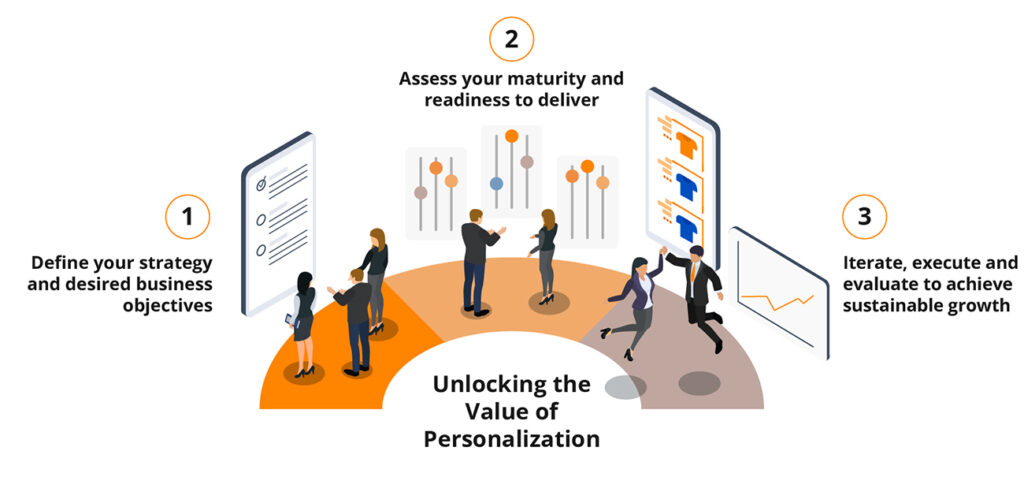
Article
Unlocking Personalization: Considerations for Execution
Ian Madell, Andrei Flueraru, Erika Siegert, Bashaar Hassan — March 28, 2024
 Canadian consumers have a clear and growing appetite for Personalization. Our research shows consumers are more likely to engage with, repurchase, and recommend brands that personalize the customer experience. While it has become a vital capability for brands, most companies struggle to unlock personalization in ways that drive sustainable growth.
Canadian consumers have a clear and growing appetite for Personalization. Our research shows consumers are more likely to engage with, repurchase, and recommend brands that personalize the customer experience. While it has become a vital capability for brands, most companies struggle to unlock personalization in ways that drive sustainable growth.
Delivering individual moments of surprise and delight by creating personalized journeys is the ultimate way for brands to build a loyal customer base by putting customer needs at the forefront.
Level5’s pragmatic approach to defining personalization is just the start, with a baseline for how to define personalization objectives in the context of your business and assess your readiness to deliver.
Personalization Maturity Model
Many organizations struggle with similar roadblocks when implementing personalization. Our Maturity Model can help break them down, by identifying key success factors and capabilities that organizations need to invest in to successfully deliver personalized experiences to customers.
The model has four dimensions that assess an organization’s personalization maturity, ranging from “Lagging” to “Leading”. There are specific actions under each dimension companies can take to deliver exceptional, personalized experiences to customers.
INFRASTRUCTURE: Does your organization’s technology infrastructure and architecture support the collection, unification, and analysis of customer data to deliver on customer needs in a timely manner?
- Keep the customer central to all your activities. Invest in the right data collection, cleaning, and storage tools to maintain high-quality customer data that eliminates siloes and enables real-time evolution.
- Design your architecture to enable employees to access the data they need. Enable the appropriate architecture for the effective distribution, and utility of customer data, enabling employees across the organization to lead with customer data.
- Optimize measurement systems to ensure you can develop and use customer-centric KPIs. Enable A/B testing and ongoing analysis that can inform live decisioning and experience delivery.
PROCESS: Do your processes enable relevant and contextual customer experiences?
- Develop Next Best Action abilities. Build an automated decisioning hub with logic that combines standard business rules with predictive and machine learning models to best determine how to interact with a customer, both proactively and reactively.
- Automate differentiated treatment pathways. Use predictive analytics to automate decision frameworks and enable complex differentiated treatment delivery in real-time.
- Break siloes, build cross-functional processes. Design and enable cross-functional processes across critical business functions to help orchestrate the delivery of personalized experiences.
TACTICS: Do you have the right tactics to deliver on a winning personalization approach?
- Prioritize experiences that drive impact. Define and prioritize omnichannel experiences that your organization can feasibly prioritize and launch.
- Integrate virtual & in-person experiences. Develop experiences that create a link between virtual and in-person benefits to capitalize on the power of it’s combined impact.
WAYS OF WORKING: Does your team feel empowered to rapidly respond to changing customer needs and preferences?
- Coordinate enterprise-wide activities. Create a customer council with clear accountabilities to oversee the end-to-end customer experience that will ensure proper orchestration of personalized experiences across all relevant channels.
- Structure teams to be nimble. Enable nimble teams that can quickly test, execute, and learn from dynamic experiences in real time.
- Building partnerships to drive improvement. Review strategic partnerships to assess their impact and value to your customers.
When building your personalization capabilities, consider common challenges and pitfalls:
- Unclear Objectives: Teams across all layers of your organization must understand the ultimate outcome of creating personalized experiences for your customers.
- Limited executive buy-in. It is essential to get top-down support to enable enterprise-wide coordination and prioritize personalization initiatives.
- Aiming for perfection. Organizations must quickly respond to constantly changing customer needs, emphasizing the need to be nimble and prioritize progress over perfection.
- Lack of centralized coordination. A customer council is necessary to establish and enforce governance practices that enable cross-functional orchestration and deliver consistent customer experiences.
Need help creating a 100-day roadmap with detailed actions and milestones aligned to the maturity model to get your personalization efforts up and running? Contact Level5 today!






